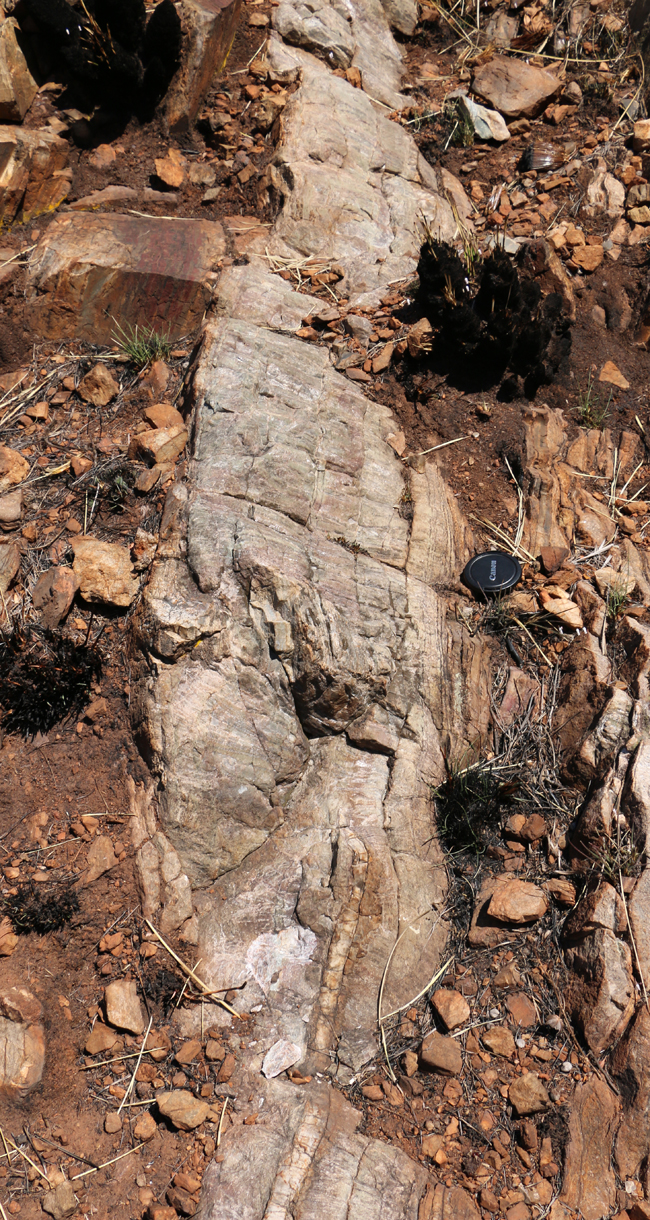During the Archean eon of geologic time, the Earth was young, and had characteristics that were both similar to what we find in the modern planet, and also seemed to have some striking differences. Examples of the former: gravity, oceans, and metamorphism. Examples of the latter: a different atmospheric mix of gases, an absence of plate tectonics, and a much hotter internal temperature (of which the komatiites I shared yesterday are one signature).
Something else that was apparently quite different was regular bombardment by large extraterrrestrial impactors – the early, messy solar system was still in the process of cleaning itself up by gravitationally merging previously isolated bodies. Large meteorite impacts would of course create a crater at the site of the impact, but continual resurfacing on the planet due to the rock cycle makes it less likely to preserve their large region-scale forms. We’ll have better luck if we consider the sedimentary record of those impacts. What sedimentary signatures would a really big impact have on its neighboring or more distant regions?
Answers can be found in the Fig Tree Group of strata, as accumulated in what today we call the Barberton Greenstone Belt. In particular, a spot called Barite Valley in Barberton Mountain Land yields key insights into two separate impact events, dubbed S2 and S3 by Don Lowe, who first described and published what I’ll show you today. We were fortunate to have Don lead us on this excellent field day, along with collaborators Gary Byerly and Christoph Heubeck, and Don’s graduate student Nadja Drabon.
A GigaPan view towards the Barite Valley:
Link GigaPan by Callan Bentley
Two views across the Barite Valley… All the rock sample and outcrop photos you’ll see in the rest of the post are encompassed in these two views:
Link GigaPan by Callan Bentley
Link GigaPan by Callan Bentley
The Archean crust subject to the impact (and perhaps the mantle directly underneath) was ultramafic in composition. Komatiitic ash deposits look like this – like a lightweight dark green chert:

In it, primary sedimentary structures such as cross-bedding may be observed:

As you might expect, this stuff apparently has an elevated iridium anomaly, suggesting extraterrestrial elemental input:

GIGAmacro images to show komatiitic composition ash deposits include primary sedimentary structures like cross-bedding:
Link GIGAmacro by Callan Bentley
Link GIGAmacro by Callan Bentley
These sedimentary breccias are interpreted as tsunami deposits, with the violent wave being the result of water displaced by the impact:



…Zooming in to the lower center of the previous image, for a closer look at the details of the texture:

Komatiitic ash with chunks of pre-impact chert in it:


The impacts could vaporize rock at the site of impact, and this rock vapor condensed in the atmosphere soon thereafter, raining down as small lithologic hailstones called “spherules”. They are layered, like jawbreaker candy, or ooids:


Each of those little spheres is an atmospheric condensate of rock vapor. They might not look like much, but realizing the utter, unimaginable violence of their formation is profound. That sort of thing is one of my favorite things about geology – being able to notice and identify something like a spherule horizon, and then to realize the enormity of what it implies.
The mind grows giddy staring so deep into the gory violence of geologic history…

Here is an impactite breccia from one impact, the S2 impact, at Barite Valley. Note the angular chert fragments as well as the spherules, all mixed in together:

Another sample, showing the Barite Valley’s gorgeous scenery in the background:

GIGAmacro view of this same sample of the “S2” Impact-generated tsunamite deposits. Explore it until you find a concentrically-layered spherule amid all the other debris…
Link GIGAmacro by Callan Bentley
Three views of a sample of the “S3” impact spherulite layer, featuring both fresh and weathered spherules, as well as a mud drape:
Link GIGAmacro by Callan Bentley
Link GIGAmacro by Callan Bentley
Link GIGAmacro by Callan Bentley
The Barite Valley gets its name from barite horizons within the sedimentary succession, with ~20 cm thick layers of chemically-precipitated barium sulfate, crystals growing up off the seafloor and fanning out. It’s distinctive stuff not only due to its coarsely crystalline texture, but also due to its density:




These unusual deposits speak of a radical change in ocean chemistry in the aftermath of these large meteorite impacts. Where did all the extra barium come from all of a sudden? Perhaps the impact punctured the crust, allowing some mantle fluid content to mix into the world ocean.

I was particularly keen to see these barite layers because similar horizons are cited as evidence for fundamental marine chemical weirdness in the aftermath of the Neoproterozoic Snowball Earth glaciations.



Outcrop of the barite horizon associated with the S2 impactite layer, suggesting a fundamental change in ocean chemistry as a result of the big event:
Link GigaPan by Callan Bentley
GIGAmacro view of two samples of the barite:
Link GIGAmacro by Callan Bentley
So there you have it: that’s what the sedimentary signature of an Archean meteorite impact looks like: It is full of tsunami breccia, fine komatiitic ash, hail-like spherules, and a barium-rich ocean’s crystal precipitation.
